For Nikolai Stanzler the issue is dying trees.
Warning! This could bring tears to your eyes. But they would be tears of gratitude.
“In a time where so many people feel powerless due to the pandemic, this was an opportunity to give power to the children by reminding them that they can make a difference in their community by being a good citizen.” That is how Erica Grech, a teacher at West Hollywood Elementary School, explains the purpose of a recent project that had first graders identify problems in their community, figure out how to address them, and then do something.
Homelessness? Trash on the sidewalks and lawns? People not wearing face coverings? People not picking up after their dogs?
Those were problems the students identified after getting out and taking a (safe) walk in the neighborhood. But unlike those folks who just gripe with their neighbors on the Nextdoor.com site, these kids took a deep dive into the issues and developed plans to deal with them.
“They had to go out around their community. They had to take a walk and see something they thought was a problem,” Grech said. “Whatever problem they chose, we went with it. They had to do some background: Why is this such a problem in the community? What can we do about it? They went around and talked to people in the community.”
“This project gave the students a hands-on experience of what it meant to be a good citizen (our social studies and English language arts theme for the month) as opposed to just reading about and discussing the concept in class,” Grech said … “The students were walked through the ‘Design Thinking Process’ and given assignments to finish for each step, in order to get them from Square 1– empathy/problem — to the end,- a solution that is tested and implemented.”
Grech documented the project with handwritten statements by the students about the problems they observed, their ideas for addressing them, tests for seeing if those ideas worked, and finally taking action. And she told the parents not to intervene. ” It was pretty wonderful to see through the eyes of a six-year-old what the problems were,” she said.
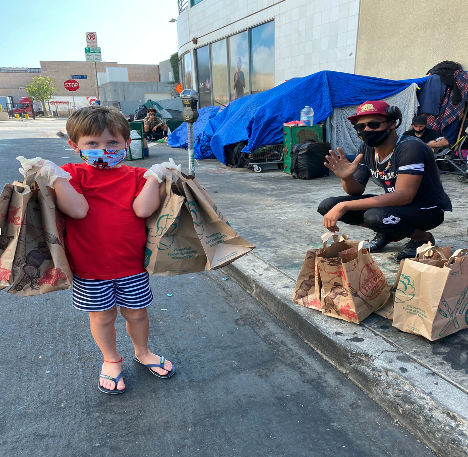
For Mason Soskin, the issue was “people without homes.”
“My solution was to bring food to the homles people,” Soskin wrote (Grech didn’t edit their essays.) “First we are going to buy the food. Next we are going to make the food. I am going to make them sandwichis. I will also bring chips and water. Then we are going to bring the food to the homeles people. I think they will be surprised to see all the food. They will feel happy.”
And indeed they were. One homeless man asked Mason for his name and then thanked him.
Nicholas Wilson also saw homelessness as an issue. “My soultion was to set up a tent camp,” the six-year-old wrote. “… There will be a food center for food. Then a bathroom. Then a hostital. There will be tents for homeless people. There will be trees for air.”
Others can join in, Nicholas wrote. “People can donate money to charities that helps homeless people. Then people can donate food to homeless people. Last the owners of buildings can lower the rents so the homeless people can afford to live there.”
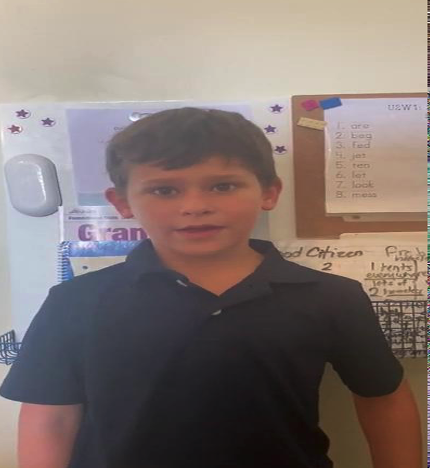
Jack Michalski saw the same issue. “My solution was to make lunch bags. We put PB and J, chips, apples, and a cookie. My mom and dad will help. We will drive it to a shelter. Some people do not have money. I will give my clothes, money, and food to help the homeless.”
And others? “They can help by working at a soup kitchen. They can help by making lunch sacks. They can donate your clothes and food. They can have a toy drive.”
Elijah Emanuel also saw people without homes as a community issue. As a six-year-old girl, Jane Baldwin was particularly concerned about children without homes, recommending that there be bins where people could easily drop off clothes and shoes for them.
Kimia Kamran is concerned about littering.
For Jack Shimer, the issue was littering. “I don’t like when pepel throw trash on the grond,” Shimer wrote. “I think we could do better than that. I want the liter to stop!”
Shimer noted that litter ended up on the shore and into the ocean. “Anther risin I dont like litter is because if we throw litter on the ground at a buutufl plays, it woued be tarabal. It wouled look so bad.”
Jack Shimer is going to go with his mother to pick up trash at the park.
His solution? “My solution was to go to the park and lace to pick up litter. I went with my mom. We brot grabers, bag, and glovs. We picked up a ton of litter. We are going to put up a poster bord at the park. My mom will help me put up the poster bord. I am going to put some stikers on it and right dont litter. I will help people not litter.”
Shimer took it even farther, saying there should be more trash cans in the city. “People can put leaves in the grean bin. They should put plastick, paper, and glass in the blue bin. Yociy stuf should be in the black bin.”
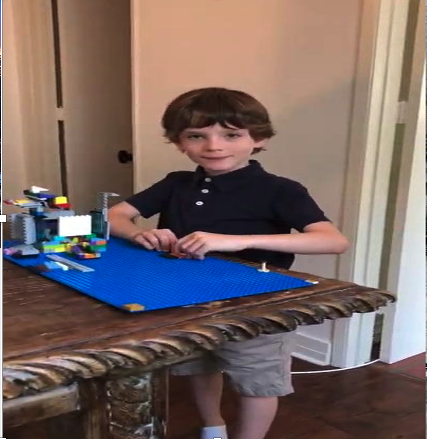
Devin Gathrid-Spilberg also saw trash as an issue. “This is on Poinsetia place where I live,” he wrote. “I see piles of garbage when I walk my dog. It smels bad! I wish people would put their garbeg in their trash cans and not on their lawn.”
Devin’s solution? “I will help by creating a garbage machine. First I will colect my materials. I used lego’s to build my garbage machine. My machine will help our planet by takeing a giant piece of garbage and munching and crunching it intel it is so, so, so small.”
Leo Deletto took a similar approach, crafting a robot (with legos) to pick up trash. He called it “Fastee the Robot.” Nathalie Fur created a poster to call out to people the harm that litter can do to the ocean.
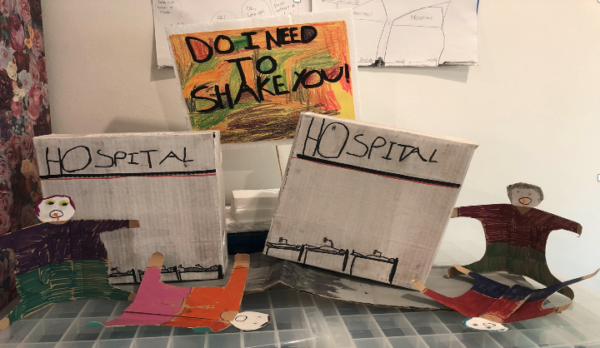
For Ethan Gathrid-Spilberg, the issue was people not wearing masks. “I don’t like when peple are not wearing a mask,” he wrote. “I feel scared. I am going to get sick … I think peple shuld weear a mask so other peple don’t get sick.”
“My solution was to make art. It was really fun because I got to use my boxes and my paints … I will turn my art into a billboard. I hope when people drive by my billboard they will feel inspired to wear a mask.” And, he added, “people can say ‘wear a mask so you don’t get other people sick,’ Police can give people a ticket if they don’t wear a mask. The city can give a mask to people who have a home and no money for free.
Grech, who has been a teacher for 15 years, said that in this atmosphere of negativity, she found the work these students did deeply moving.
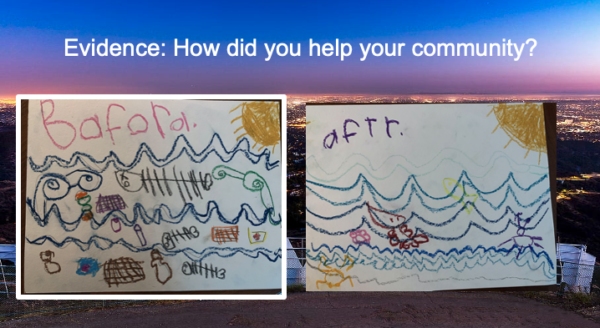
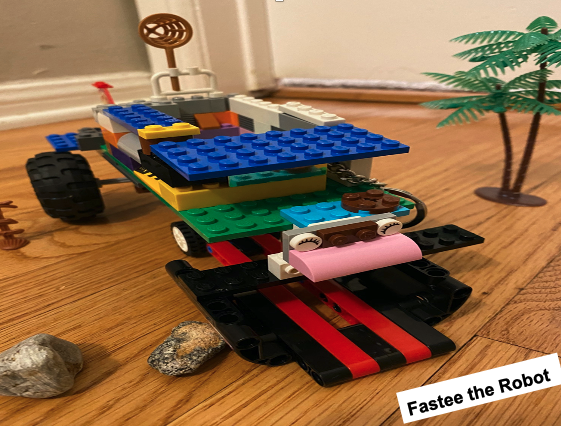

Great story! Would love to see more like ti from our elementary and even high schools.
This is absolutely awesome. West Hollywood elementary is an amazing school and so are all it’s teachers. Ms. Grech is an great example of what a teachers should be. WehoVille please publish more stories about your local school. Thank you.
I nominate all of the children mentioned in this article for West Hollywood City Council. Too late? Maybe. Too soon? I don’t think so.
Ms. Grech’s class did a wonderful job. Great pictures Nathalie!!